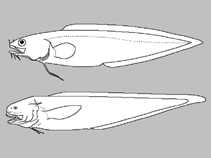http://www.fishbase.org/Summary/speciesSummary.php?genusname=Porogadus&speciesname=abyssalis ---> http://192.134.151.83/Summary/speciesSummary.php?genusname=Porogadus&speciesname=abyssalis
http://192.134.151.83/Summary/speciesSummary.php?genusname=Porogadus&speciesname=abyssalis ---> https://fishbase.mnhn.fr/Summary/speciesSummary.php?genusname=Porogadus&speciesname=abyssalis
https://fishbase.mnhn.fr/Summary/speciesSummary.php?genusname=Porogadus&speciesname=abyssalis ---> https://fishbase.mnhn.fr/summary/Porogadus-abyssalis.html
Porogadus abyssalis

You can
sponsor
this page
Common name (e.g. trout)
Genus + Species (e.g. Gadus morhua)
-

-
About this page
-
Languages
-
User feedbacks
-
Citation
-
Uploads
-
Related species
-


 Upload your
photos
and
videos
Upload your
photos
and
videos
Google image
 No image available for this species;
No image available for this species;
drawing shows typical species in Ophidiidae.
Teleostei (teleosts) >
Ophidiiformes
(Cusk eels) >
Ophidiidae
(Cusk-eels) > Neobythitinae
Etymology:
Porogadus:
Greek, poros = porous + Latin, gadus = a fish, cod? (Ref.
45335
)
.
Environment: milieu / climate zone / depth range / distribution range
Ecology
Marine; bathydemersal; depth range ? - 5300 m (Ref.
34024
). Deep-water
Atlantic Ocean: known from the holotype collected north of the Romanche Trench and reported from 2 specimens off northeastern Brazil.
Size / Weight / Age
Maturity: L
m
?
range ? - ? cm
Max length : 20.9 cm SL male/unsexed; (Ref.
3686
)
Short description
Morphology
|
Morphometrics
This species is distinguished by the following characters: precaudal vertebrae 18-19; lower part of first gill arch with long gill rakers 13-14; pectoral-fin rays 19-23; HL:HD 1.85-2.09; most head spines are moderately strong or weak, present on ethmoidal, prefrontal, interorbital, supraorbital, sphenotic, inner preopercular rim and none on lacrimal, 5th infraorbital, supratemporal, inner and outer posttemporal, outer preopercular rim; opercular spine sharp and extruding; opercular flap small; lower lateral line pores until beginning of anal fin 23; moderately broad dentition patch on vomer with 2-3 rows of teeth and on palatines with 2-4 rows of teeth; otolith with single colliculum; OL:OH = 1.17; OL:TCL = 2-3 (Ref.
125143
).
Rare species (Ref.
34024
). Reproductive strategy possibly similar to other members of this family featuring oviparity, with oval pelagic eggs floating in a gelatinous mass (Ref.
205
).
Life cycle and mating behavior
Maturity
|
Reproduction
|
Spawning
|
Eggs
|
Fecundity
|
Larvae
Schwarzhans, W.W. and P.R. Møller
, 2021. Revision of the ‘dragon-head’ cusk eels of the genus
Porogadus
(Teleostei: Ophidiidae), with description of eight new species and one new genus. Zootaxa 5029(1):001-096. (Ref.
125143
)
IUCN Red List Status (Ref.
130435
)
Data deficient (DD)
; Date assessed:
09 July 2014
CITES
Not Evaluated
Not Evaluated
Threat to humans
Harmless
Human uses
Fisheries: of no interest
FAO - Publication:
search
|
FishSource
|
More information
Countries
FAO areas
Ecosystems
Occurrences
Introductions
Stocks
Ecology
Diet
Food items
Food consumption
Ration
Common names
Synonyms
Metabolism
Predators
Ecotoxicology
Reproduction
Maturity
Spawning
Spawning aggregation
Fecundity
Eggs
Egg development
Age/Size
Growth
Length-weight
Length-length
Length-frequencies
Morphometrics
Morphology
Larvae
Larval dynamics
Recruitment
Abundance
BRUVS
References
Aquaculture
Aquaculture profile
Strains
Genetics
Electrophoreses
Heritability
Diseases
Processing
Nutrients
Mass conversion
Collaborators
Pictures
Stamps, Coins Misc.
Sounds
Ciguatera
Speed
Swim. type
Gill area
Otoliths
Brains
Vision
Tools
E-book
|
Field guide
|
Length-frequency wizard
|
Life-history tool
|
Point map
|
Classification Tree
|
Catch-MSY
|
Special reports
Check for Aquarium maintenance
|
Check for Species Fact Sheets
|
Check for Aquaculture Fact Sheets
Download XML
Summary page
|
Point data
|
Common names
|
Photos
Internet sources
AFORO (otoliths) |
Aquatic Commons
|
BHL
|
Cloffa
|
BOLDSystems
|
Websites from users
|
Check FishWatcher
|
CISTI
|
Catalog of Fishes
:
genus
,
species
|
DiscoverLife
|
ECOTOX
| FAO - Publication:
search
|
Faunafri
| Fishipedia |
Fishtrace
| GenBank:
genome
,
nucleotide
| GloBI |
Google Books
|
Google Scholar
|
Google
| IGFA World Record |
MitoFish
|
Otolith Atlas of Taiwan Fishes
|
PubMed
| Reef Life Survey | Socotra Atlas |
Tree of Life
| Wikipedia:
Go
,
Search
| World Records Freshwater Fishing |
Zoobank
|
Zoological Record
Estimates based on models
Phylogenetic diversity index (Ref.
82804
): PD
50
= 0.5001 [Uniqueness, from 0.5 = low to 2.0 = high].
Bayesian length-weight: a=0.01000 (0.00244 - 0.04107), b=3.04 (2.81 - 3.27), in cm total length, based on all LWR estimates for this body shape (Ref.
93245
).
Trophic level (Ref.
69278
): 3.5 ±0.6 se; based on size and trophs of closest relatives
Resilience (Ref.
120179
): Medium, minimum population doubling time 1.4 - 4.4 years (Assuming tmax>3).
Fishing Vulnerability (Ref.
59153
): Low vulnerability (16 of 100).
Back to Search
Random Species
Back to Top
Accessed through:
Not available
FishBase mirror site :
localhost
Page last modified by :
mrius-barile
- 20 July 2016
Fatal error
: Uncaught ArgumentCountError: Too few arguments to function checkEcotox(), 1 passed in /var/www/html/summary/speciessummary.php on line 2304 and exactly 3 expected in /var/www/html/includes/speciessummary.lib.php:2579 Stack trace: #0 /var/www/html/summary/speciessummary.php(2304): checkEcotox() #1 {main} thrown in
/var/www/html/includes/speciessummary.lib.php
on line
2579
|